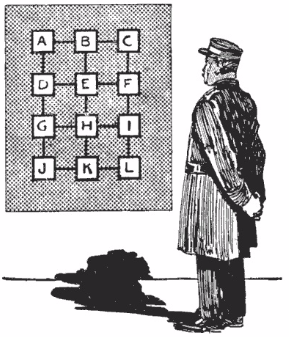Batch 3 - Class 122 - Raindrops and Spaghetti
Pre-Class Problem:
(Dudeney 242) A tube inspector has been appointed, and he has to inspect the 17 lines connecting 12 stations of the tube regularly. In each phase, he wants to cover as little distance as possible to inspect the entire system. Each link is 1 mile long. Provide the shortest route that enables him to do so - he is free to start and end at any station.

- Answer: 19 miles - BADGDEFIFCBEHKLIHGJK. Can also be thought of as BADEFCBEHKLIHGJK - this leaves DG and FI links which can be traversed twice whenever we are at any of these 4 stations.
Attendance: Muskaan, Manya, Arnav, Anishka, Arnav, Khushi, Aneeya, Zorawar, Siddhant, Tishyaa
Class Notes:
Raindrops
There is a grid with numbers. Raindrops start falling from the top and fall to the largest number below them (of those directly under, and one to the left and right below). Trace the patterns of these raindrops.
- Do the raindrops tend to converge to certain paths?
- Do the raindrops always fall to the same number in the end?
- What kind of patterns will get the raindrops to similar end states?
Spaghetti
Grids represent plates of spaghetti. You may start eating a spaghetti from any number, and then go to the smallest adjacent (4 sides) number, and so on. The objective is to not break the spaghetti, i.e. always have a place to go to an unvisited square. Is it always possible to do so on the given grids?
- Try with 4x4, 6x6, 8x8 grid - do you see patterns of starting squares that succeed and those dont?
- Can you think about why these patterns are occuring?
- Can you predict the 10x10 pattern?
- What happens with an odd number plate, like 5x5 - what pattern do you see?
- Are there perfect patterns - Can you number a 4x4 grid in a form that all the squares are valid starting points?
- Can you do so with a 6x6 plate? 8x8?
- Is there a pattern to perfect plates?
- In the first problem, where do most spaghettums land up - trace the end points from various start points.
- Whats the best you can do with a plate like this?
.png)
- Answer:
.png)
Homework
There are 25 horses, but only one race track where 5 horses can race at a time. What is the minimum number of races required to determine the 3 fastest horses in order. Horses can be raced over and over again, and take the same time to run the track.
- Answer: 7. Race 5 groups of 5 horses each (5 races). Now race the winners of each race (6th race) - this gives the fastest horse. The next two fastest horses must be out of (a) the second and third from the initial race of the fastest horse; (b) the first and second from the 6th-race-runner-up's initial race; (c) Third horse from the 6th race. Race these 5 horses in the 7th race.
References: